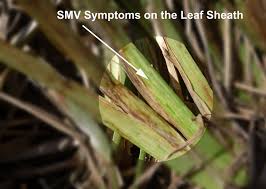 Seems as if this deadly grass disease is once again rearing it's ugly head in Venetian Isles. New yards have been diagnosed with this disease on Michigan Ave North. Hawaii Ave North has also had this problem. I am not sure about other streets. New Outbreaks in Florida Beginning in 2013, outbreaks were identified in Pinellas County and Palm Beach County. Symptoms include the leaf mosaic pattern, but leaves also become necrotic (turn brown and die prematurely). According to Phil Harmon, UF/IFAS Plant Diagnostic Center, symptoms present as blotchy or streaky patterns of yellow and green color. Turfgrass tends to have broken yellow streaks running between the veins on an otherwise green blade. Symptoms of recently reported cases include mosaic, but then turn necrotic. The symptoms and dieback typically start in the fall months of September and October, and continue through the winter into spring. Some lawns may appear to recover in the spring. Unfortunately, lawns that appear to recover eventually die over a period of 1-3 years. Infected lawns may completely dieback. To minimize disease spread in areas where the virus occurs, mowers and other equipment should be sanitized between properties. The objective is to minimize movement of potentially infected plant material from lawn to lawn, so return clippings where the virus is known to occur rather than removing them from properties. We do want to remove clippings and any other plant material from equipment before moving to another lawn and then spray down parts of equipment or worker’s shoes that have the potential to transfer plant sap using dilute bleach, quaternary ammonia (Greenshield), alcohol, or another sanitizing agent according to the directions. When mowing multiple lawns where the virus is known to occur, mow apparently healthy lawns before those with mosaic symptoms and avoid mowing symptomatic lawns when the turf grass canopy is wet (avoid mowing when dew, irrigation, or rainfall persists). Fungicides and other pesticides are ineffective and cannot stop development or spread of this viral disease. Also, there are no known agronomic inputs that homeowners or lawn care companies can use to cure a lawn once it has become infected. The disease severity, which ranges from yellowing to death, will vary from lawn to lawn by variety of grass and by other environmental factors not well understood at this time. One potential complicating factor is that lawns with mosaic may also suffer from fungal diseases, but it is not known what impact one disease has on the severity of the others. Managing fungal diseases on lawns with mosaic has not been observed to impact development of the viral disease. Lawn Replacement St. Augustine ‘Floratam’ turfgrass has exhibited the most severe symptoms. ‘Floratam’ lawns that have died due to SCMV are susceptible to dying again if replaced with ‘Floratam’. The current recommendation is to replace lawns that have died as a result of SCMV with a more resistant turfgrass. ‘Palmetto’ and ‘Bitterblue’ are more resistant, but may still get the disease. Zoysiagrass is not known to be a host of SCMV. Although other grasses such as bermudagrass, seashore paspalum and bahiagrass have been reported with SCMV infections, St. Augustine is the only turfgrass of concern in Florida at this time. If you suspect that your lawn is affected by SCMV submit a sample to your local UF/IFAS Extension office or to the UF/IFAS Plant Diagnostic Center. For information on how to collect and submit a sample go to: http://plantpath.ifas.ufl.edu/Clinic/index.shtml. Check the Rapid Turfgrass Diagnostic Service Facebook page at https://www.facebook.com/RapidTurfgrassDiagnosticService for up-to-date information on the spread of this disease. Please speak with your lawn service and pest control company about diagnosing this deadly disease. Comments are closed.
|
Categories |
